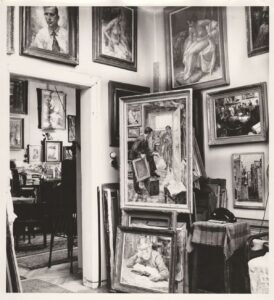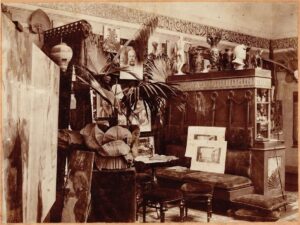The Collection of Furniture and Household Objects at the
Bukovac House
The Collection of Furniture and Household Objects at the Bukovac House comprises over 200 museum artifacts, including various types of furniture and household objects, personal belongings, and items related to the artist’s studio.

The majority of these objects were found arranged in rooms on the first floor of the house, likely in 1964, after Bukovac’s daughters bequeathed them, along with the artworks and the house itself, to the Yugoslav Academy of Sciences and Arts, and had to wait for a few more years thereafter for the opening of the Vlaho Bukovac Memorial Museum.
Ultimately, in 1974, following the assumption of management by the Municipality of Dubrovnik and the Museum of Modern Art, Vlaho Bukovac’s childhood home became open to the public. However, visitors were limited to accessing solely the second floor of the house. This area was reached from the upper garden via a concrete bridge, replacing Bukovac’s original wooden footbridge. Room was available for exhibiting only paintings, easels, and painting supplies. Meanwhile, other materials waited decades for their turn to be exhibited.

In 2001, after the formation of the Municipality of Konavle and the establishment of the Museums and Galleries of Konavle, they assumed control of the Bukovac House and began its restoration. At last, it received the kind of presentation that Bukovac’s daughters had advocated for until their passing. The furniture was in very poor condition, and its restoration began with the renovation of the house, a process that continues to this day.
In the meantime, several valuable pieces of household furniture were acquired for the collection, and the holdings were augmented by the generosity of donors with items that once belonged to the Bukovac family.
Most of the furniture was purchased by Vlaho Bukovac during his time in Paris, infusing a unique freshness and ambiance into the space of a typical Cavtat home, atypical only in terms of its owner.
Some of the objects were part of the furnishings in the grand Bukovac House built on Tomislav Square, opposite the Art Pavilion in Zagreb, according to the design of architects Hönigsberg and Deutsch. The house was constructed using the dowry of Vlaho’s wife, Jelica, and served as the family home for just shy of two years. The collection also includes personal items that once belonged to other members of Vlaho’s family.
All objects from the collection, both furniture and various examples of crockery and porcelain, offer insights into the lifestyle and culture of the eclectic 19th century, turning into the early 20th century, and represent a tangible reflection of European spaces in which Bukovac resided and worked.


